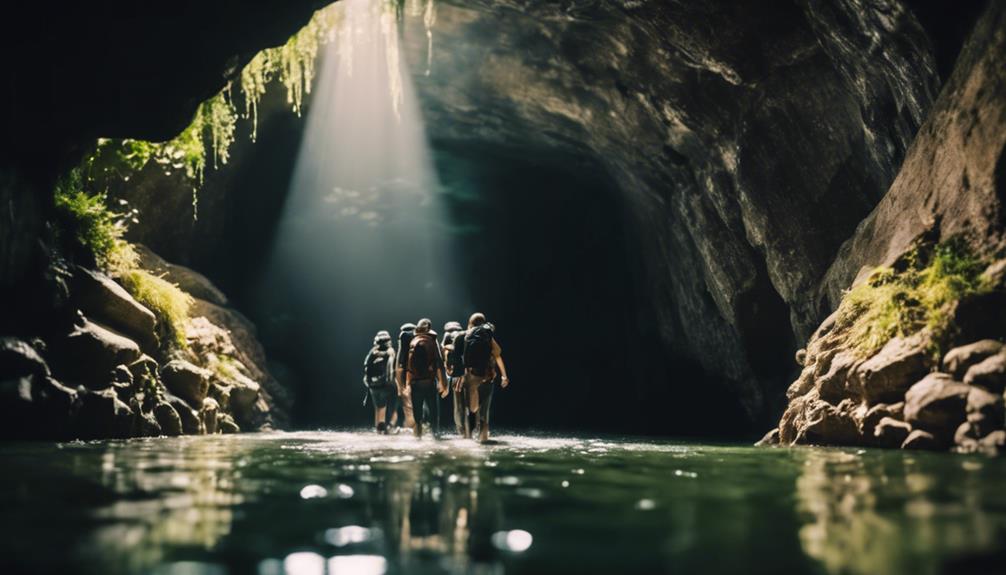Five tourists were rescued after a scary 26-hour experience underground at the Grand Canyon Caverns, where an elevator malfunction left them trapped 200 feet below the surface. Local authorities closely monitored the situation, maintaining constant communication with the group to ensure their safety. Emergency response teams were quickly mobilized, preparing for a rapid extraction. This incident highlights the crucial importance of safety protocols at tourist sites. The Grand Canyon Caverns, famous for its breathtaking geological formations and unique underground accommodations, continues to be a sought-after destination. For more details about the incident and its effects on tourism, additional information is available.
Key Takeaways
- Five tourists were trapped for 26 hours underground due to an elevator malfunction at Grand Canyon Caverns, located 200 feet below the surface.
- The Coconino County Sheriff's Office monitored the situation while maintaining communication with the trapped group to ensure their well-being.
- Emergency response teams were on standby, and a maintenance crew was deployed to address the elevator issues promptly.
- The incident highlighted the importance of safety measures in tourist attractions, emphasizing the need for ongoing improvements.
Incident Overview

Five tourists found themselves in a precarious situation after being trapped underground for 26 hours at the Grand Canyon Caverns due to an elevator malfunction. The incident occurred 200 feet below the surface, prompting immediate concern from local authorities.
The Coconino County Sheriff's Office confirmed the details and monitored the situation closely, as search and rescue teams were prepared to assist if repairs took longer than anticipated. Communication with the trapped group was maintained throughout the ordeal, ensuring their well-being.
The method of rescue remains unspecified, yet authorities prioritized resolving the elevator issue swiftly. This incident underscores the importance of safety measures in tourist attractions, even in locations renowned for their geological wonders.
Grand Canyon Caverns Features

The Grand Canyon Caverns, recognized as the largest dry caverns in the United States, offer visitors a unique opportunity to explore stunning geological formations and participate in themed tours, all while descending 200 feet underground. The caverns are renowned not only for their size but also for the diverse experiences they provide.
- Themed Tours: Engage in ghost walks and historical explorations that highlight the caverns' rich past.
- Unique Accommodations: Stay in an underground suite for an unparalleled lodging experience at $1,000 per night.
This blend of adventure and education makes the Grand Canyon Caverns a must-visit destination for tourists seeking extraordinary experiences.
Emergency Response Actions

Emergency response actions were promptly initiated when reports of the trapped tourists emerged, with search and rescue teams placed on standby to guarantee a swift recovery.
The Coconino County Sheriff's Office coordinated efforts, prioritizing communication with the tourists to assure their well-being during the ordeal.
A hoisting apparatus was prepared for potential evacuation, reflecting the proactive measures taken in response to the elevator malfunction.
Local authorities assessed the situation, working closely with the cavern management to expedite repairs and facilitate a safe rescue.
The maintenance team was deployed to address the elevator issues, emphasizing the urgency of restoring access.
Throughout, the focus remained on assuring the safety of the trapped individuals while minimizing risks associated with the rescue operation.
Visitor Experience Insights

Following the resolution of the recent incident, it is important to reflect on the overall visitor experience at Grand Canyon Caverns, which is designed to be both engaging and safe for all guests. The caverns not only offer breathtaking geological formations but also provide a variety of themed experiences that enhance visitor engagement.
- Safety Protocols: Extensive measures guarantee guest safety throughout tours.
- Unique Tours: Various options, from historical explorations to ghost walks, cater to diverse interests.
Visitor feedback consistently highlights the uniqueness and allure of exploring these ancient formations.
Ongoing improvements in safety measures emphasize the commitment to a secure environment for all adventurers.
Adventure Tourism Trends

Growing enthusiasm for adventure tourism reflects a broader consumer desire for unique and immersive experiences that connect them with nature and history.
This trend is marked by an increasing willingness to engage in activities that push physical and psychological boundaries, such as spelunking, rock climbing, and extreme hiking.
Adventure tourism providers are responding by enhancing safety measures and developing diverse offerings that appeal to both novice and seasoned adventurers.
Additionally, the integration of technology, like virtual reality previews and mobile apps, is elevating the planning and experience of adventure trips.
As affluent travelers seek exclusive experiences, businesses are innovating with high-end accommodations, such as luxury underground suites, ensuring that safety and comfort remain paramount in this dynamic sector.
Is There a Connection Between the Viral Video and the Tourists’ Underground Ordeal?
The viral video sparks resignation as officials are under fire for failing to address the tourists’ underground ordeal. Many are questioning if there’s a connection between the viral video and the harrowing experience faced by the tourists. Investigations are underway to uncover the truth behind this disturbing incident.
How Did They Survive Such a Long Ordeal?
After a lengthy legal process, the tenant eviction battle resolved in their favor, allowing them to keep their home. It’s incredible how they survived such a long ordeal, but their determination and resilience ultimately paid off. Now, they can finally breathe a sigh of relief and move forward with their lives.
Conclusion
The recent incident at Grand Canyon Caverns serves as a critical reminder of the inherent risks associated with adventure tourism.
Theories surrounding the safety of underground environments suggest that rigorous engineering standards and thorough emergency protocols are essential in mitigating potential hazards.
As the tourism industry continues to expand, prioritizing visitor safety through enhanced crisis management strategies will be paramount.
This event highlights the necessity for ongoing assessment and improvement of safety measures to prevent future emergencies in high-risk tourist destinations.









